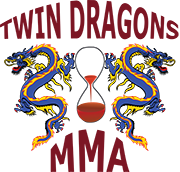Vocabulary
Every sport or profession has its vocabulary to learn. Martial arts is no exception. Below is a list of some of the important vocabulary terms that we use during our sessions at Twin Dragons MMA. To emphasize and respect the traditional Korean roots of the martial arts taught at our studio, we use Korean vocabulary.
An-nyong ha-shim-ni-ka (안녕하십니까)
Korean for “How are you doing?” We use this greeting to begin each class as a sign of respect for our instructors and fellow students.
KAm-sa-ham-ni-da (감사합니다)
Korean for “Thank you.” We use this to end each class to thank our instructors and fellow students.
Cheer-ee-ott (차렷)
Korean for “Come to attention.”
Kun-Yae (경례)
Korean for “Bow.” As a sign of respect, we bow to our instructors and to our fellow students.
Joon-Bee (기본준비)
Korean for “Ready stance.”
Bah-roe (바로)
Korean for “Return to ready stance.”
Shee-oe (바로)
Korean for “Bow and return to parade rest.”
Shee-oe (바로)
Korean for “Bow and return to parade rest.”
Hapkido (합기도)
The Art of Coordinated Powers.
Taekwondo (태권도)
The Art of Hand and Foot.
Palgwe (팔괘)
The Eight Powers of the Universe:
- Heaven
- Lake
- Fire
- Thunder
- Wind
- Water
- Mountain
- Earth
Counting in Native Korean
The native Korean counting system is used in our studio in most cases, such as counting steps in forms, counting exercise reps, etc.
- 하나 (hana)
- 둘 (dul)
- 셋 (set)
- 넷 (net)
- 다섯 (daseot)
- 여섯 (yeoseot)
- 일곱 (ilgop)
- 여덟 (yeodeol)
- 아홉 (ahop)
- 열 (yeol)
Counting in Sino-Korean (Chinese System)
China influenced the writing and counting system of Korea. The Sino-Korean system is used in the names of Taek Kwon Do forms (example: palgwe il jang – Palgwe form 1).
- 일 (il)
- 이 (i)
- 삼 (sam)
- 사 (sa)
- 오 (o)
- 육 (yuk)
- 칠 (chil)
- 팔 (pal)
- 구 (gu)
- 십 (sip)
